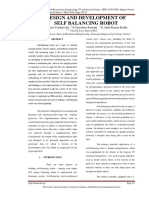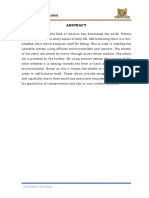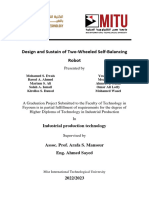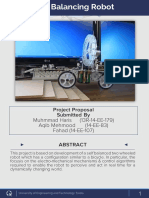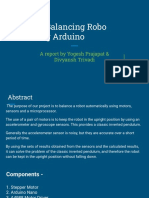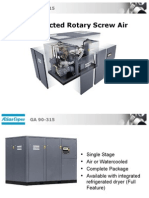A New Design and Control of A Two-Wheel Self-Balancing Robot Using The Arduino Microcontroller
Uploaded by
رشيد بن صغيرA New Design and Control of A Two-Wheel Self-Balancing Robot Using The Arduino Microcontroller
Uploaded by
رشيد بن صغيرISSN (Online) 2395-2717
International Journal of Engineering Research in Electrical and Electronic
Engineering (IJEREEE)
Vol 4, Issue 2, February 2018
A new Design and Control of a Two-Wheel Self-
Balancing Robot using the Arduino Microcontroller
[1]
S.Manikandan, [2] Reshma, [3] G Vani prasanna, [4] Ch Swetha, [5] V S Hariharan
[1]
Professor, [2][3][4] Student, [5] Principal
Dept of EEE, Balaji Institute of Technology and Science, Warangal, Telangana
Abstract: -- In the last decade, the open source community has expanded to make it possible for people to build complex products at
home. [1] In this thesis a two wheeled self-balancing robot has been designed. These types of robots can be based on the physical
problem of an inverted pendulum [2]. In this paper, we can see the design, construction and control of a two-wheel self-balancing
robot. This system consists of a pair of DC motor and an Arduino UNO R3 microcontroller board, make a robot which can balance
itself on two wheels the platform will not remain stable itself. Our job will be to balance the platform using distance sensors and to
maintain it horizontally. At first, we have decided to just balance the robot on its two wheels.
Keywords: — Robot, Arduino, AT mega 328, Control Systems, PID controller, Linear Quadratic Regulator.
This paper is arranged as follows: The Section 2 describes the
hardware and system architecture of the robot. The designs of
I. INTRODUCTION filters, inner control loop to equilibrate the two motors,and
To make a robot which can balance itself on two wheels. balancing control in Section 3. Finally Section 4 represents the
There will be only one axle connecting the two wheels and a experimental results, followed by some conclusion in Section
platform will be mounted on that .There will be a another 5.
platform above it. The platform will not remain stable itself.
Our job will be to balance the platform using distance sensors II. STRUCTURE OF THE TWO-WHEEL BALANCING
and to maintain it horizontal. At first we have decided to just ROBOT
balance the robot on its two wheels. Basically, a two-wheel
self-balancing robot is very similar to the inverted pendulum, In the structure of a self-balancing robot can be classified into
and which is an important test part in control system and three parts such as sensors, motor and motor control, and
research education purpose; let us see, for an example [5], [6]. develop board [4], [5]. In Section II-A introduces the
A Two-wheeled self-balancing vehicle commercially known application and advantage of the sensors on the proposed
as “Segway”.And also the Segway can never stay balancing robot, andalso how these sensors are employed to
upright.Besides the development of Segway, studies of two- obtain measurements of acceleration, and distance
wheel self-balancing robots have been widely reported. For traveled,androbot tilt angle. The Section II-B describes the
example, JOE [5] and nBot [6] are both early versions motor selection and control for the balancing robot. And
complete with inertia sensors and motor encoders and also Section II-C discusses the reason behind choosing the Arduino
along with on-vehicle microcontrollers. Arduino is an open develop board, and how it is deployed.
prototyping platform based up on Atmega processors .And It
will be a fast becoming popular platform for both education
[7] and product development, with applications ranging from
robotics [8], [9] to process control [10], [11] and networked
control [12].In this paper, we report a student project on the
basis of design, construction and control of a two-wheel self-
balancing robot with Ardunio software. The robot is driven by
two DC motors, and is equipped with an Arduino Uno board
which is based on the ATmega328 microprocessor, and also
including with a single-axis gyroscope and a 2-axis
accelerometer for attitude determination. In order to
compensate for gyro drifts common in COTS sensors, a
complementary filter is implemented [13]. For two wheel
control designs are based up on the linearized equations of
motion, such as a proportional-integral-differential (PID) Fig 1: Self Balancing Robot
control.
All Rights Reserved © 2018 IJEREEE 11
ISSN (Online) 2395-2717
International Journal of Engineering Research in Electrical and Electronic
Engineering (IJEREEE)
Vol 4, Issue 2, February 2018
A. Selection and Application of Sensors UNO features 54 general-purpose digital I/O pins of which 15
In order to make balance of the robot, there are two things provide PWM output. And alsosome of the digital I/O pins
must needed one is robot’s tilt angle and angular velocity. It is also support serial communication such as I2C and SPI, as
possible by using MEMS sensors. And it may also including a well as interrupt handles. The board also features sixteen 10-
gyroscope, wheel-angle encoders, and alsoan accelerometer bit analog inputs for 0-5V input, giving a quantization limit of
and we can measure all the data needed for balancing control. 4.9mV.
1) Gyroscope: Gyroscope measures the angular rate around an
axes. Tilt angle can be obtained by integrating angular rate
over sampled time. An estimate of angular displacement is
obtained by integrating velocity signal over time.
2)Accelerometer: This meter is used to measures the total
external acceleration of the balancing robot, and also which
includes the gravitational and motion accelerations.
Accelerometer can measure the force of gravity and with that
information, the angle of robot can be obtained. Kalman filter Fig. 2. Architecture of the controlled system
is used for the fusion of outputs of two sensors. 3) Price and Expansions: As we all know Arduino boards are
3) Encoders: In generally the encoders return the rotation low-cost and expandable, where optional peripherals called
angles of individual motor shafts as digital signals, which are shields can be purchased as and when needed.
sent to the processor. Next, after conversion based on gear D. Power Supply : In generally power supply, the motors a
ratio and wheel radius, the distance traveled can be calculated. voltage between 12V to 16V, and for the development voltage
The encoder chosen for this project is the 64 cycle-per- between 5V to 15V.These analog voltages lie in therange from
revolution, which provides a resolution of 64 counts per 0V to 5V.
revolution of the motor shaft.
III. ANGLE ESTIMATION AND BALANCING
B. Motor Control Board CONTROL
One of the most important part in balancing robot is Dc
Motor. It emphasizes torque output instead of velocity, The fig 2 represents the system architecture of the self-
because it has to oppose the rotational moment that gravity balancing robot. A balancing controller which delivers a
applies on the robot.Hence, the motors need to provide enough motor-control signal, and a inner-loop controller for wheel
torque to correct the robot’s body pose back to a balanced synchronization. And also a Feedback is provided through a
position. complementary filter. The filter function is to provide an
Generally, Each motor provides a torque of 200 oz-in, estimate of the robot tilt angle from gyroscope and
sufficient for our purpose. The maximum operating current accelerometer measurements.
and voltage ratings are givenas 14 Ampere and 16 Volts.
C. Arduino Mega Development Board
Selection of the development board is based on
the following features:
1) Performance: Normally, the self-balancing robot needs
almost real-time response to estimate and correct its tilt
angle.Hence, the development of board must provide a
processing speed that is sufficiently fast to perform the
processing tasks, including data acquisition, control
computation and signal output, within the sampling time.The
Arduino Mega development board is equipped with the
ATmega328 processor, which features a maximum clock rate
of 16 MHz.
2) Input / Output Pins:On the robot, sensors are deployed to
obtain measurements of its motion: a gyroscope and an
accelerometer are used to estimate the tilt angle,encoders are
used to obtained the measurements of the robot. The Arduino Fig 3: Tilt velocity of the robot body
All Rights Reserved © 2018 IJEREEE 12
ISSN (Online) 2395-2717
International Journal of Engineering Research in Electrical and Electronic
Engineering (IJEREEE)
Vol 4, Issue 2, February 2018
A. Angle Estimation via Complementary Filter
In Section II, a gyroscope is used to measure the angular
velocity of the robot. And accelerometer measures the Y - and
Z-components of gravitationalacceleration, encoders measure
the distancetravelled by the wheels.For thebalacning control,
the tilt angle is corrected to the upright position. Balancing
control is possible by using wheel motion of the robot. In
order to solve the problem of angle measurement, we can
design a complementary filter [13], a block diagram of which
is as shown in Fig. 3.
Fig. 6. Tilt angle estimation.
Here Blue line represents: output value of
complementaryfilter; red line represents: direct integration of
Fig. 4. Block Diagram of the Complementary Filter gyroscope angular rate; green line represents: angle deduced
from accelerometer measurement using the direction
Next tuning the filter, its performance under noise isfirst tested cosinemethod.
in simulation as shown in Fig. 4, whichcompares the three
ways to estimate the tilt angle. As we know, the best estimate B. Synchronization of a Inner-loop Control for Wheel
of the angle is provided by the complementary filter. Here, we If we can assume ideally, if the same motor control signal is
can see the same result is also observed in experiment, as sent to the motors control board, both motors should rotate at
shown in Fig.5 the same speed. A method is used to synchronize both
motors is needed.
Fig. 7. Block diagram of wheel synchronizer.
Fig 5: Sense tilt and drive wheels to make robot erect
Fig. 8. Test results of wheel travel distances.
All Rights Reserved © 2018 IJEREEE 13
ISSN (Online) 2395-2717
International Journal of Engineering Research in Electrical and Electronic
Engineering (IJEREEE)
Vol 4, Issue 2, February 2018
This gain uses the derivative of the error to reduce the
Top: The wheels’travel distances coincide when wheel overshoot of the output erivative gain This gain uses the
synchronization control is employed. derivative of the error to reduce the overshoot of the output.
Bottom: At equal motor input, the wheels travel at different erivative gain This gain uses the derivative of the error to
speed withwithout wheel synchronization. reduce the overshoot of the output.
C. Balancing Control Designs Derivative gain:
Here In this project, two control design strategies are studied The gain is uses the derivative of the error to reduce the
one is proportional-integral-differential (PID) control, and overshoot of the output. The three gains, kP, kI and kD are
proportional-integral proportional-differential (PI-PD) control tunable parameters and must be adjusted according to the
[6] based on linear-quadratic-regulator (LQR) design. specific hardware used. There are very many ways to tune
these parameters to an optimal value. We used the manual
method to do this. First, we set all the gains to 0. Then kP is
increased until the response oscillates. Then kP is set to half
its value. kI is now increased until the steady state error is
corrected in sufficient time. Finally, kD is increased to
minimize overshoot.
2) LQR, Linear Quadratic Regulator
To control a linear system ,LQR-control can be applied. The
states of the dynamical system are described by a state space
model including the matrices A, B and C as seen in Figure 11:
Fig. 9. Definition of motion variables
1) PID Control:
Fig 11: Block representation of state space system showing
the system matrices A, B and C as well as the gain matrix K.
The Design of the Self-Balancing Robot LQR Controller. The
LQR method is the most mature controller design method in
the development of modern control theory [15]; LQR optimal
Fig. 10. Block diagram of PI-PD controller
control is to seek the control amount 𝑢∗(𝑡) to make the system
The block diagram of the PID controller is as shown in Fig.
reach the steady state and guarantee the performance index 𝐽
10, where the complementary filter generates estimates of the
to take the minimum value:
angular velocity and angle.
𝐽 = ∫ ∞ 0 (𝑋𝑇𝑄𝑋 + 𝑢𝑇𝑅𝑢) 𝑑t
Proportional gain:
This gain directly relates to the current error to the current The parameter of the robot is shown in below table:
motor output. This forms the bulk of the gain in the controller
and reacts instantly to any error
Integral gain:
This gain compensates for any steady state error caused by
drift or the offsets in the center of mass of the robot. It works
by integrating the values of error over a period of time and
hence reacts to steady state error after it accumulates.
Derivative gain
All Rights Reserved © 2018 IJEREEE 14
ISSN (Online) 2395-2717
International Journal of Engineering Research in Electrical and Electronic
Engineering (IJEREEE)
Vol 4, Issue 2, February 2018
IV. EXPERIMENTAL RESULTS
The figure shown below shows the working of the Self
Balancing Robot with Ardunio Microcontroller
Fig 12: Combined outputs Series1-gravity angle(only
accelerometer reading) Series2-stabilized angles(combined
readings)
V. CONCLUSION
This paper presents an experimental, Arduino based, low cost
self-balancing robot as an educational control system.Low-
cost communicate hardware such Xbee may be added to the
robot, so that the user can control its motion remotely and read
the data via telemetry. Also, user-controlled motion such as
forward, backward, turn right and left, may be implemented.A
possible extension is to combine the Arduino system and other
sensors such ultrasonic and IR senses, GPS, digital compass
and Camera to address other advanced applications, e.g.
obstacle avoidance and perimeter following. The main
drawback that hampers the overall project result its unable to
attain. Therefore appropriate conclusions are not able to
achieve. The problem with the oscillation still remains with
the system and future work has to be done to achieve a stable
solution.
VI. FUTURE IMPROVEMENT
The stabilization provided by the reaction wheel is limited be
the torque provided by the reaction wheel motor. Subsequent
plan is to use a rotating disc and its gyroscopic precession for
balancing. This would provide a more stable design capable of
providing higher restoring torque .In such a case particular
attention should be paid to any rotary axes, their alignment,
and how they are fixed to the model, to the position and
alignment of brackets, and to the mounting and fastening of
any flexible couplings. In addition to this, fuzzy logic
Fig 11: Individual outputs of accelerometer and gyro controller can also be implemented to provide flexibility and
accuracy in control.
All Rights Reserved © 2018 IJEREEE 15
ISSN (Online) 2395-2717
International Journal of Engineering Research in Electrical and Electronic
Engineering (IJEREEE)
Vol 4, Issue 2, February 2018
REFERENCES [12] V. Georgitzikis and I. Akribopoulos,
O.andChatzigiannakis, “Controlling physical objects via the
[1] Arduino. [Online]. Available: http://arduino.cc internet using the Arduino platform over 802.15.4 networks,”
IEEE Latin America Transactions, vol. 10, no. 3, pp. 1686–9,
[2] D. Arndt, J. E. Bobrow, S. Peters, K. Iagnemma, and S. 2012.
Bubowsky, “Two-wheel self-balancing of a four-wheeled
vehicle,” IEEE Control Systems Magazine, vol. 31, no. 2, pp. [13] A.-J. Baerveldt and R. Klang, “A low-cost and low-
29–37, April 2011. weight attitude estimation system for an autonomous
helicopter,” in IEEE International Conference on Intelligent
[3] R. Fierro, F. Lewis, and A. Lowe, “Hybrid control for a Engineering Systems, sep 1997, pp. 391–5.
class of underactuated mechanical systems,” IEEE
Transactions on Systems, Man and Cybernetics, Part A: [14] R. C. Ooi, “Balancing a two-wheeled autonomous robot,”
Systems and Humans, vol. 29, no. 6, pp. 649–4, nov 1999. Final Year Thesis, The University of Western Australia,
School of Mechanical Engineering, 2003.
[4] K. Xu and X.-D.Duan, “Comparative study of control
methods of single-rotational inverted pendulum,” in [15] L. Cheng, H. Dewen, P. Yaodong, Z. Xiaocai, and D.
Proceedings of the First International Conference on Machine Guohua, “Fuzzy control of a quintuple inverted pendulum
Learning and Cybernetics, vol. 2, 2002, pp. 776–8. with the LQR method and 2-ary fuzzy piecewise interpolation
function,” in Proceedings of the 45th IEEE Conference on
[5] F. Grasser, A. D’Arrrigo, S. Colombi, and A. C. Rufer, Decision and Control (CDC ’06), pp. 6307–6312, December
“JOE: A mobile, inverted pendulum,” IEEE Transactions on 2006.
Industrial Electronics, vol. 49, no. 1, pp. 107–14, 2002.
[6] D. P. Anderson. (2003, Aug.)nBot balancing robot.
Online.[Online]. Available: http://www.geology.smu.edu/
dpa-www/robo/nbot
[7] J. Sarik and I. Kymissis, “Lab kits using the Arduino
prototyping platform,” in IEEE Frontiers in Education
Conference, 2010, pp. T3C– 1–5.
[8] G. Guo and W. Yue, “Autonomous platoon control
allowing rangelimited sensors,” IEEE Trans. on Vehicular
Technology, vol. 61, no. 7, pp. 2901–2912, 2012.
[9] P. A. Vignesh and G. Vignesh, “Relocating vehicles to
avoid traffic collision through wireless sensor networks,” in
4th International Conference on Computational Intelligence,
Communication Systems and Networks. IEEE, 2012.
[10] M. J. A. Arizaga, J. de la Calleja, R. Hernandez, and A.
Benitez, “Automatic control for laboratory sterilization
process rsd on Arduino hardware,” in 22nd International
Conference on Electrical Communications and Computers,
130-3, Ed., 2012.
[11] S. Krivic, M. Hujdur, A. Mrzic, and S. Konjicija, “Design
and implementation of fuzzy controller on embedded
computer for water level control,” in MIPRO, Opatija,
Croatia, May 21–25 2012, pp. 1747–51.
All Rights Reserved © 2018 IJEREEE 16
You might also like
- Design and Control of A Two-Wheel Self-Balancing Robot Using The Arduino Microcontroller BoardNo ratings yetDesign and Control of A Two-Wheel Self-Balancing Robot Using The Arduino Microcontroller Board3 pages
- Under The Guidance Of:-Mr. Prahakant Dwivedi (Assistant Professor)No ratings yetUnder The Guidance Of:-Mr. Prahakant Dwivedi (Assistant Professor)17 pages
- Design and Control of Two-Wheeled Self-Balancing Robot Using ArduinoNo ratings yetDesign and Control of Two-Wheeled Self-Balancing Robot Using Arduino7 pages
- Controlling of Two Wheeled Self Balancing Robot Using PIDNo ratings yetControlling of Two Wheeled Self Balancing Robot Using PID6 pages
- Two Wheels Self Balancing Robot: Group MembersNo ratings yetTwo Wheels Self Balancing Robot: Group Members15 pages
- EE 361: Control Systems: Spring 2019 Project ProposalNo ratings yetEE 361: Control Systems: Spring 2019 Project Proposal7 pages
- EE 361: Control Systems: Spring 2019 Project ProposalNo ratings yetEE 361: Control Systems: Spring 2019 Project Proposal7 pages
- Self Balancing Robot Report - Team YEEET!No ratings yetSelf Balancing Robot Report - Team YEEET!4 pages
- Self Balancing Two Wheeled Robot ReportNo ratings yetSelf Balancing Two Wheeled Robot Report11 pages
- Self Balancing Two Wheeled Robot ReportNo ratings yetSelf Balancing Two Wheeled Robot Report11 pages
- Design and Control of Two-wheeled Self-Balancing Robot Using ArduinoNo ratings yetDesign and Control of Two-wheeled Self-Balancing Robot Using Arduino6 pages
- Automatic Balancing Robot: Madhuram.M (Assistant Professor)No ratings yetAutomatic Balancing Robot: Madhuram.M (Assistant Professor)12 pages
- Updated Self Balancing Report (F16mte28)No ratings yetUpdated Self Balancing Report (F16mte28)25 pages
- Design of Self Balancing Robot Using Accelerometer and Gyroscopic SensorsNo ratings yetDesign of Self Balancing Robot Using Accelerometer and Gyroscopic Sensors2 pages
- Self Balancing Robot: International Journal For Research in Applied Science & Engineering Technology (IJRASET)No ratings yetSelf Balancing Robot: International Journal For Research in Applied Science & Engineering Technology (IJRASET)5 pages
- twowheelselfbalancingrobot-141211054955-conversion-gate01No ratings yettwowheelselfbalancingrobot-141211054955-conversion-gate0113 pages
- Pragmatic Internet of Everything (IOE) for Smart Cities: 360-Degree PerspectiveFrom EverandPragmatic Internet of Everything (IOE) for Smart Cities: 360-Degree PerspectiveNo ratings yet
- Design, Build, and Test of An Autonomous Myrio Based SegbotNo ratings yetDesign, Build, and Test of An Autonomous Myrio Based Segbot6 pages
- 2 Wheel Self-Balancing Robot: Eric WangNo ratings yet2 Wheel Self-Balancing Robot: Eric Wang16 pages
- Board 144 Maker A 3d Printed Balancing Robot For Teaching Dynamic Systems and ControlNo ratings yetBoard 144 Maker A 3d Printed Balancing Robot For Teaching Dynamic Systems and Control9 pages
- 2017 Wang-Nguyen - Self-Balancing Robot PosterNo ratings yet2017 Wang-Nguyen - Self-Balancing Robot Poster1 page
- Pulse Motor Free Energy Generator For Electric Car Charging SystemNo ratings yetPulse Motor Free Energy Generator For Electric Car Charging System5 pages
- 12 Physics Notes Ch01 Electric Charges and FieldNo ratings yet12 Physics Notes Ch01 Electric Charges and Field3 pages
- Machine Learning Guide: Meher Krishna PatelNo ratings yetMachine Learning Guide: Meher Krishna Patel121 pages
- BSL Method Statememt For Lifting Thermal Tank - 1No ratings yetBSL Method Statememt For Lifting Thermal Tank - 14 pages
- MCQ For SNVM Startup and New Venture ManagementNo ratings yetMCQ For SNVM Startup and New Venture Management24 pages
- Class Schedule Sy 2021 2022 Senior High SchoolNo ratings yetClass Schedule Sy 2021 2022 Senior High School2 pages
- 300V2 - 4T - Factory - Line 10W-50 DATASHEETNo ratings yet300V2 - 4T - Factory - Line 10W-50 DATASHEET2 pages
- Week 4 Quiz: Differential Calculus: Uses of The Derivative: Increasing and Decreasing FunctionsNo ratings yetWeek 4 Quiz: Differential Calculus: Uses of The Derivative: Increasing and Decreasing Functions7 pages
- ISO 15189 Accreditation: Benita I.Haines Corporate Compliance and Quality Manager For Valley Health July 19, 2009No ratings yetISO 15189 Accreditation: Benita I.Haines Corporate Compliance and Quality Manager For Valley Health July 19, 200915 pages
- LESSON-3 History of Global Politics Creating An International Order100% (1)LESSON-3 History of Global Politics Creating An International Order40 pages
- Affinity Laws For Variable Speed Centrifugal PumpsNo ratings yetAffinity Laws For Variable Speed Centrifugal Pumps4 pages
- Ciara Della-Flora SHE (Technology's Influence On Psychological Mental Health)No ratings yetCiara Della-Flora SHE (Technology's Influence On Psychological Mental Health)3 pages
- Badri Engineering Corporation: One Stop Shop For All Your Industrial NeedsNo ratings yetBadri Engineering Corporation: One Stop Shop For All Your Industrial Needs2 pages
- Mathcad Prestressed Concrete Jefferson ExampleNo ratings yetMathcad Prestressed Concrete Jefferson Example222 pages
- Design and Control of A Two-Wheel Self-Balancing Robot Using The Arduino Microcontroller BoardDesign and Control of A Two-Wheel Self-Balancing Robot Using The Arduino Microcontroller Board
- Under The Guidance Of:-Mr. Prahakant Dwivedi (Assistant Professor)Under The Guidance Of:-Mr. Prahakant Dwivedi (Assistant Professor)
- Design and Control of Two-Wheeled Self-Balancing Robot Using ArduinoDesign and Control of Two-Wheeled Self-Balancing Robot Using Arduino
- Controlling of Two Wheeled Self Balancing Robot Using PIDControlling of Two Wheeled Self Balancing Robot Using PID
- EE 361: Control Systems: Spring 2019 Project ProposalEE 361: Control Systems: Spring 2019 Project Proposal
- EE 361: Control Systems: Spring 2019 Project ProposalEE 361: Control Systems: Spring 2019 Project Proposal
- Design and Control of Two-wheeled Self-Balancing Robot Using ArduinoDesign and Control of Two-wheeled Self-Balancing Robot Using Arduino
- Automatic Balancing Robot: Madhuram.M (Assistant Professor)Automatic Balancing Robot: Madhuram.M (Assistant Professor)
- Design of Self Balancing Robot Using Accelerometer and Gyroscopic SensorsDesign of Self Balancing Robot Using Accelerometer and Gyroscopic Sensors
- Self Balancing Robot: International Journal For Research in Applied Science & Engineering Technology (IJRASET)Self Balancing Robot: International Journal For Research in Applied Science & Engineering Technology (IJRASET)
- twowheelselfbalancingrobot-141211054955-conversion-gate01twowheelselfbalancingrobot-141211054955-conversion-gate01
- Pragmatic Internet of Everything (IOE) for Smart Cities: 360-Degree PerspectiveFrom EverandPragmatic Internet of Everything (IOE) for Smart Cities: 360-Degree Perspective
- Design, Build, and Test of An Autonomous Myrio Based SegbotDesign, Build, and Test of An Autonomous Myrio Based Segbot
- Board 144 Maker A 3d Printed Balancing Robot For Teaching Dynamic Systems and ControlBoard 144 Maker A 3d Printed Balancing Robot For Teaching Dynamic Systems and Control
- Pulse Motor Free Energy Generator For Electric Car Charging SystemPulse Motor Free Energy Generator For Electric Car Charging System
- Week 4 Quiz: Differential Calculus: Uses of The Derivative: Increasing and Decreasing FunctionsWeek 4 Quiz: Differential Calculus: Uses of The Derivative: Increasing and Decreasing Functions
- ISO 15189 Accreditation: Benita I.Haines Corporate Compliance and Quality Manager For Valley Health July 19, 2009ISO 15189 Accreditation: Benita I.Haines Corporate Compliance and Quality Manager For Valley Health July 19, 2009
- LESSON-3 History of Global Politics Creating An International OrderLESSON-3 History of Global Politics Creating An International Order
- Affinity Laws For Variable Speed Centrifugal PumpsAffinity Laws For Variable Speed Centrifugal Pumps
- Ciara Della-Flora SHE (Technology's Influence On Psychological Mental Health)Ciara Della-Flora SHE (Technology's Influence On Psychological Mental Health)
- Badri Engineering Corporation: One Stop Shop For All Your Industrial NeedsBadri Engineering Corporation: One Stop Shop For All Your Industrial Needs












